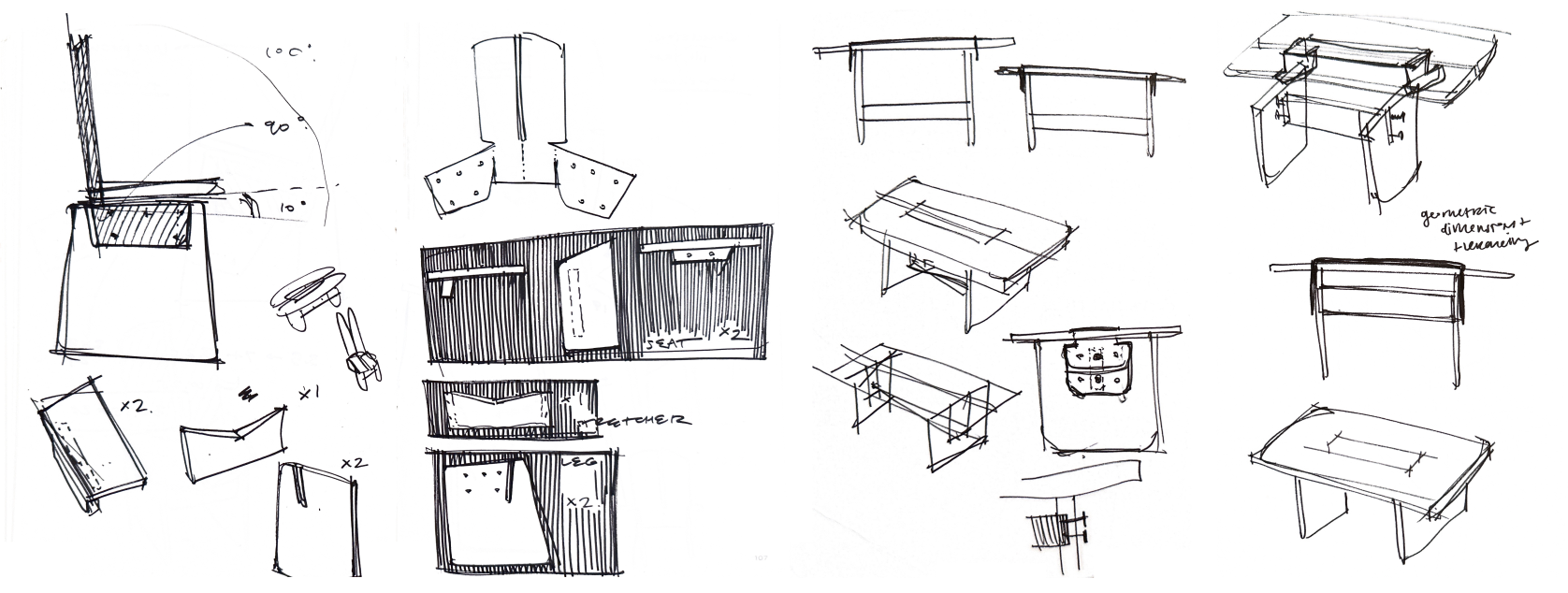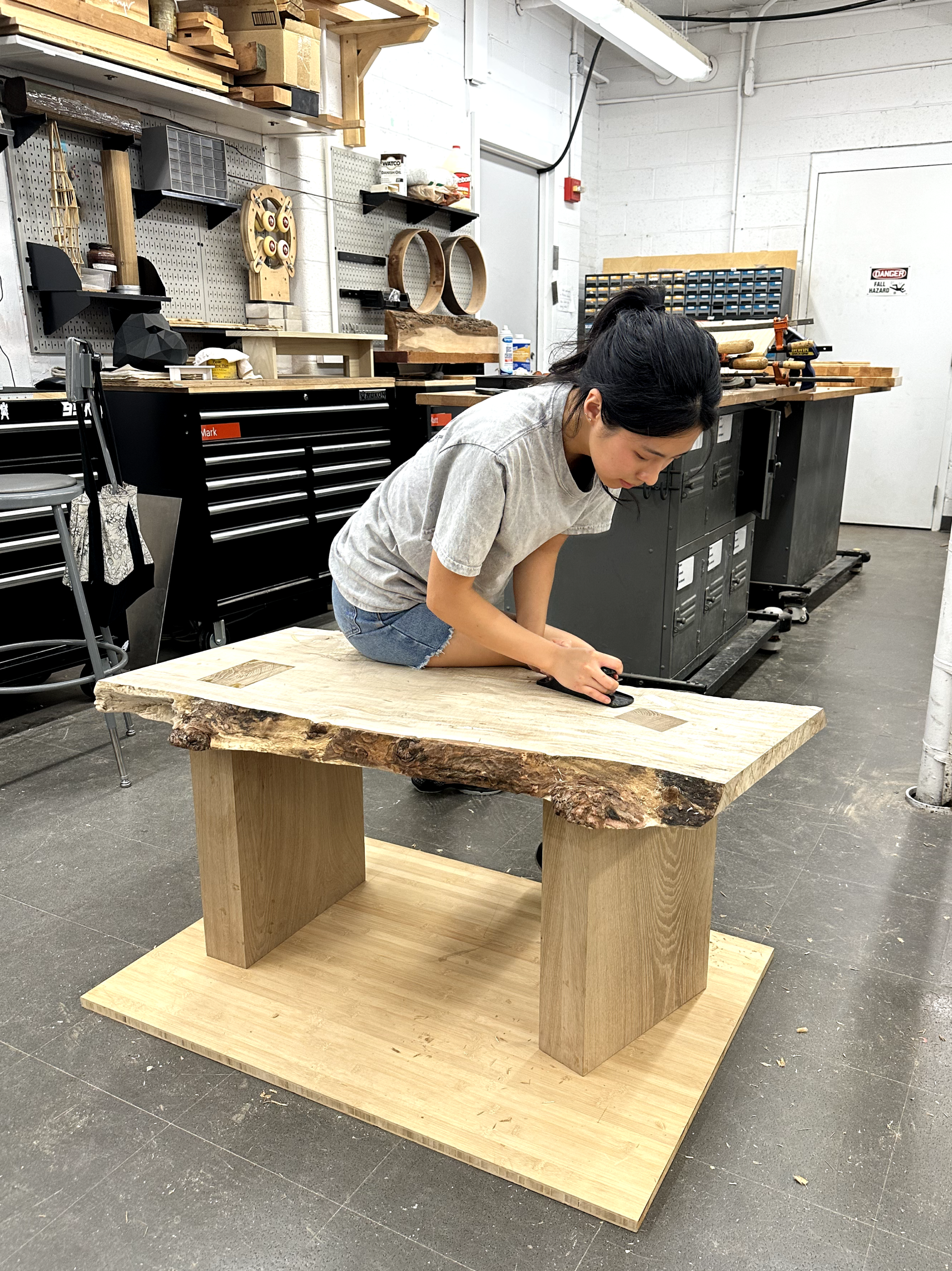Heart Bench
Bench with hearts inspired by the paintings and craft of my late grandmother, who was the reason I grew up making. Explores the expansion of a multi-generational design practice and materialization of a delicate, feminine motif through the very permanent medium of fine furniture.
Duration
January - April 2024Course
Furniture IIMaterials
Locally Sourced Ambrosia Maple, White Oak, Brass InlayTools
Jointer, Planer, Drum Sander, Drill Press, Bandsaw, Table Saw, Router, Hand Router, Tracksaw, Hand PlaneMade possible by the Frank-Ratchye Further Fund
Furniture Design
Wood-working
Metal-working

I wanted to blur the lines between found and designed object; and in it challenge myself to design with, for, and around a material entity I can’t control.
Special thanks to local woodshop Urban Tree, where I learned about and experienced firsthand the sustainable sourcing and processing of lumber from Pittsburgh’s urban forest.
Discoloration from insect activity throughout the life of the tree are sensitively met with brass inlays to form heart shapes, inviting touch and wear over time. The motif is inspired by my late grandmother’s paintings and craft— she was always filling the home with hearts big and small, so I grew up surrounded by objects that felt like “I love you’s.”
As an object, it exists somewhere between the realms of found object, graphic composition, and functional equipment. My goal was to strike a tasteful balance between intention and serendipity.
Special thanks to local woodshop Urban Tree, where I learned about and experienced firsthand the sustainable sourcing and processing of lumber from Pittsburgh’s urban forest.
Discoloration from insect activity throughout the life of the tree are sensitively met with brass inlays to form heart shapes, inviting touch and wear over time. The motif is inspired by my late grandmother’s paintings and craft— she was always filling the home with hearts big and small, so I grew up surrounded by objects that felt like “I love you’s.”
As an object, it exists somewhere between the realms of found object, graphic composition, and functional equipment. My goal was to strike a tasteful balance between intention and serendipity.







Background
Previously, I’d designed and built this furniture collection, which required the materials— white oak and sheet aluminum— to come together in a highly controlled way.



My previous designs for a table and chair collection.
This time, I wanted to challenge myself to design entirely around the inherent properties of a piece of material that I couldn’t control.



Exploring with found branches and bark.
Sourcing
My first step was to source a live edge slab. I reached out to Urban Tree, a local, full-cycle workshop which reclaims Pittsburgh’s aging urban forest and transforms the lumber into one-of-a-kind furniture.



After perusing the countless slabs of urban lumber, I finally chose this piece of Ambrosia Maple that came from a residence in Allison Park, PA. Many thanks to Jason Boone, who flattened the piece for me on their custom router sled.

Inspiration
At the same time, as an exercise, we were asked to reflect on and bring in three objects that were significant to our developing craft. Mine included:
1. A wide hake brush, with which I had learned to paint watercolor, representing my background in the fine arts. All my life, I’ve really just wanted to make beautiful things. It was also this formal art training that first taught me to use the inherent properties of a medium the way it wants to be used (in this case watercolor; freely and serendipitously.)
2. A threaded insert, representing standardization and the affordance of modularity and mass manufacture. Something that has always fascinated me about design is the intersection between the special and distributable, and the opportunity for something very good to be experienced by many.
3. My grandmother’s three-dimensional “collages.” She was the reason I grew up making. Reminiscing on some of the things she had made or been drawn toward, and the resulting decor and furniture I had grown up around, I noticed a lot of hearts. Between her roles as both a painter and a mother; both an artist and a homemaker, evident was her persisting devotion to fill her own home with love, beauty, and wonder.





Between Form and Graphic
From here I had two goals; to use the live edge slab, and to bring in hearts.
It was a challenge to try to incorporate such a strong graphic element, especially one that might err toward being cheesy or cliche, into a material that was already so characteristic.
I spent a lot of time with the slab and sketched and modeled a lot.
Build
Each of the white oak legs had to be split four ways and glued back together because of the limitations of the shop machinery.
I carefully arranged the legs with the end-grain that would be visible in mind and used the drill press and dowels for alignment.




Inlays
I revisited the water-jet cutter to cut the metal inlays.
Because they were so small, I added tabs to prevent them from falling into the machine. I used a jeweler’s saw and files to cut and smooth them by hand.



The negatives were routed out using the Shaper Origin, then epoxied in. I tested several offset dimensions to get the tightest fit.



Mortises
I created the mortises by first drilling starter holes, then using a jig saw to roughly cut out their shape. I cleaned them up with laser-cut guides, a router, and a top-bearing flush trim bit. Because the slab was so thick, I also needed to flip it upside down and do another pass with the router, this time using a bottom-bearing flush trim bit, from the other side.
Corners were cleaned up by hand with chisels.






Tenons
The tenons were cut roughly on the bandsaw, then cleaned up with the router and chisels using the same method as the mortises.




Edge Treatment
I cleaned up the edges of the slab where I wanted in response to the rest of the graphic composition, using a tracksaw. I considered leaving those sides as is, or filleting or chamfering different edges.
I finally decided to chamfer the bottom edges using a fairly large bit, to give the bench a bit more of a lifted and ceremonial feeling. I created jigs with scrapwood to make the routing process smoother and safer.




Assembly and Finish
Test fitting and (an intense, four-person) glue-up.


Hand planing to get the tenons perfectly flush to the bench surface.


Sanding and finishing. To keep the wood finish as natural as possible, I used a water-based polycoat.




Special thanks to Professor Matt Zywica, 3D Lab Managers Josiah Stadelmeier and Hali Simmons, Ed Wojciechowski and John Fulmer from CMU Tech Spark, Harrison Apple and the Frank-Ratchye STUDIO for Creative Inquiry, and Jason Boone and the rest of the team at Urban Tree.
and fellow furniture makers Jayden Liu and John Henley.



and for my 할머니, my lifelong inspiration.